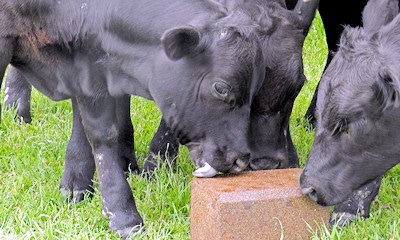November 2, 2015

Sponsored Content
Stocker cattle represent a great opportunity to turn forages into profit for the savvy cattleman. Stocker calves represent a lot of potential gain, but also a lot of potential loss. The keys to a successful stocker program lie in pasture management, cost control and animal management.
Pasture Management
Stocker cattle perform better on low-cost forages with a little help.
One of the cheapest things you can do to increase weight gain in your stocker calves is to properly fertilize and lime pastures. Properly fertilized forages contain more nutrients needed by cattle to gain weight quickly. The best way to fertilize and lime your pastures is to take a soil sample several months before the forage growing season (for example, take a soil sample in the early fall for winter wheat or ryegrass). Based on the results of the soil sample lime and/or fertilize the pasture accordingly.
Another important aspect of pasture management is weed control. For every pound of weeds in your pasture there is one less pound of usable forages for your stocker calves. Your local Cooperative Extension agent can help you choose the correct herbicide and advise you on the correct time to apply them to remove unwanted weeds.
Cost Control
Obviously, to make money raising stocker cattle you have to sell the cattle for more than you put in them. Carefully controlling input costs like feed, medication, supplements, etc. and making sure that these items result in added benefits that are worth the cost is crucial. It is beneficial to keep a record of all costs incurred, not only for tax purposes, but to help you determine your breakeven costs for future years.
Proper Animal Management
When processing stocker calves, it makes sense to perform a few management procedures to increase their value. These include castrating bull calves and dehorning any horned cattle, as well as deworming and vaccinating all calves. The mere act of dehorning and castrating will increase the calves’ value by several cents per pound at sale time. Vaccinating and deworming cattle will reduce your death losses and increase productivity because sick cattle don’t efficiently gain weight.
Properly matching cattle-types to available forages will also maximize productivity and weight gain. The highest quality forages should be matched up with lightweight calves, while heavier calves can be placed on slightly more mature, less nutritious forages with no loss in production.
Make sure that calves have free access to water and a complete mineral supplement. A lack of either will reduce feed intake and thus reduce potential weight gains. It is also a good idea to supplement stocker calves with an ionophore to increase feed efficiency and weight gains. Feeding an ionophore to stocker cattle allows you to graze more calves on the same amount of pasture (without decreasing weight gain!) or graze the same number of calves for a longer period of time. Either way you end up with more pounds of cattle at the end of the grazing period as compared to not supplementing with an ionophore. More pounds at the sale barn means more money in your pocket!
How Does an Ionophore Increase Feed Efficiency?
The ionophores [monensin (Rumensin®) or lasalocid (Bovatec®)] alter the population of rumen bugs to increase the amount of “good” bacteria and decrease the populations of “bad” bacteria. These “good” bacteria produce higher amounts of propionic acid. The reason that this is important is that a calf utilizes acetic acid, butyric acid and propionic acid produced by the rumen bugs as energy. However, the calf is able to more efficiently convert propionic acid into energy than either butyric acid or acetic acid. More propionic acid means more energy for the calf, resulting in greater weight gains. The “bad” bacteria produce more acetic acid, butyric acid, carbon dioxide and methane resulting in more wasted energy from your forages.
How Should I Feed Rumensin®?
When high quality forages are available to stocker cattle, the protein levels in these forages are typically adequate to meet the needs of growing stocker calves, so extra protein usually isn’t needed. Self fed pressed blocks provide essential levels of minerals and vitamins in addition to Rumensin® for added weight gain without the cost of protein that you don’t need. And probably the greatest advantage of self fed pressed blocks is their ease of use. These weather-resistant blocks can be placed right out in the pasture with the calves. Maintenance merely involves keeping the proper number of blocks available to the calves at all times.
Visit www.sweetlix.com for more information about how SWEETLIX® Rumensin® Pressed Blocks can benefit your stocker operation.
Rumensin® is a registered trademark of Elanco Animal Health
Bovatec® is a registered trademark of Zoetis
You May Also Like




